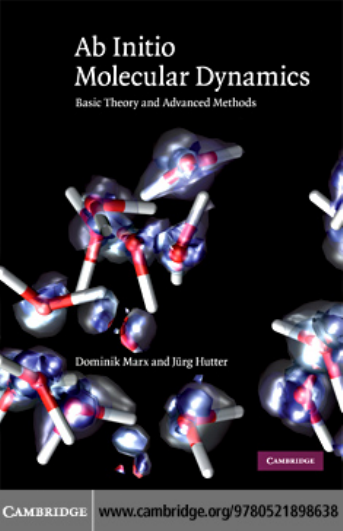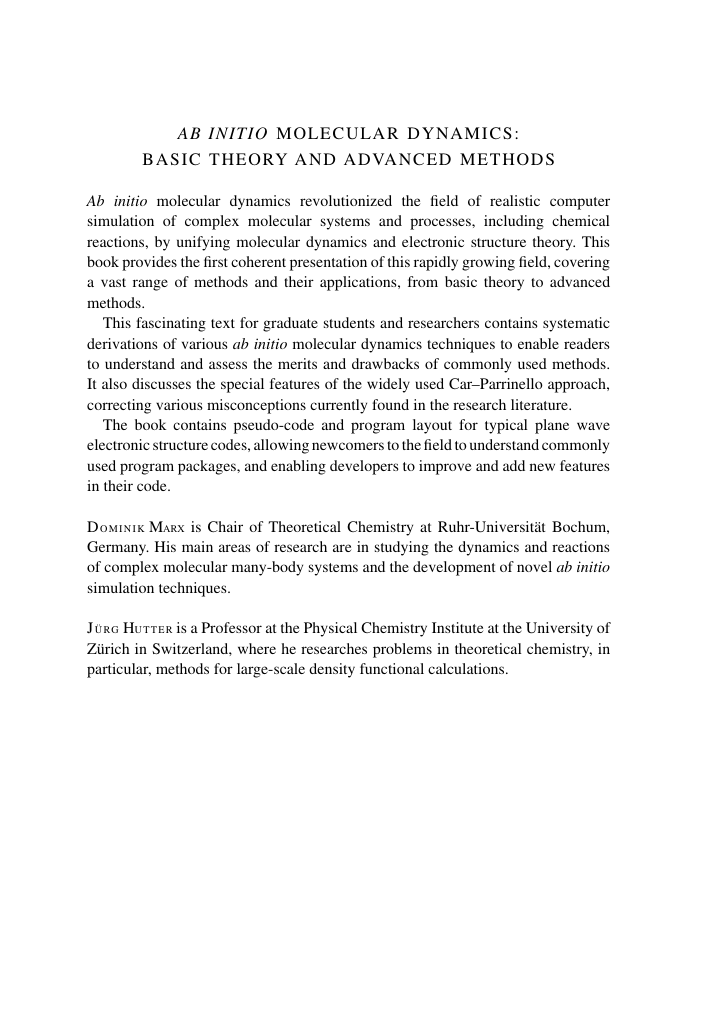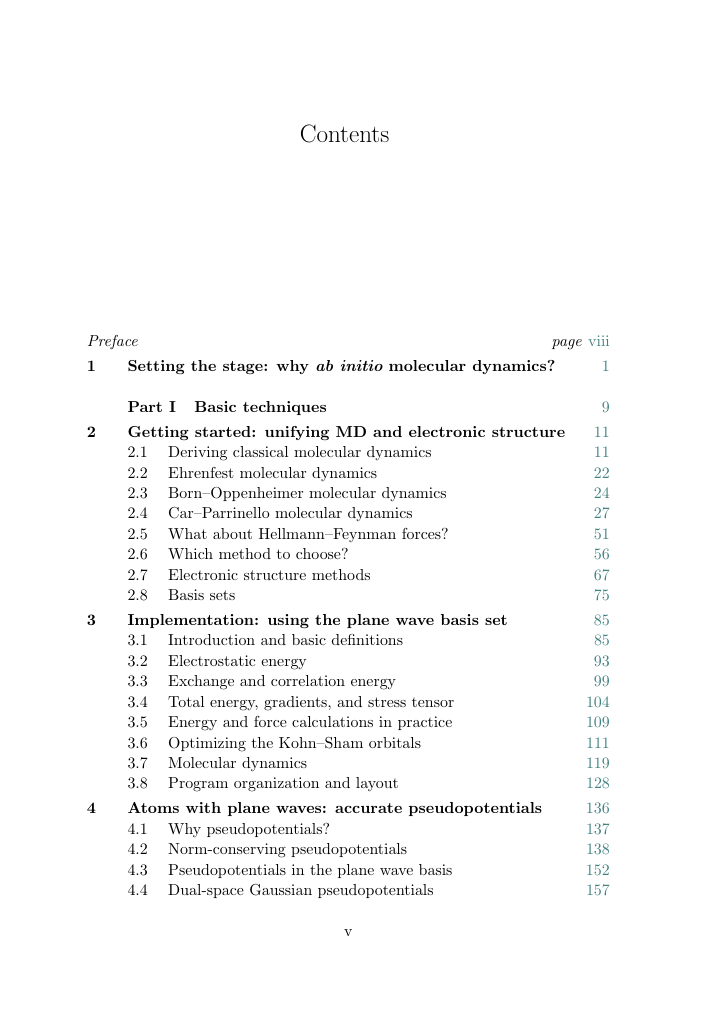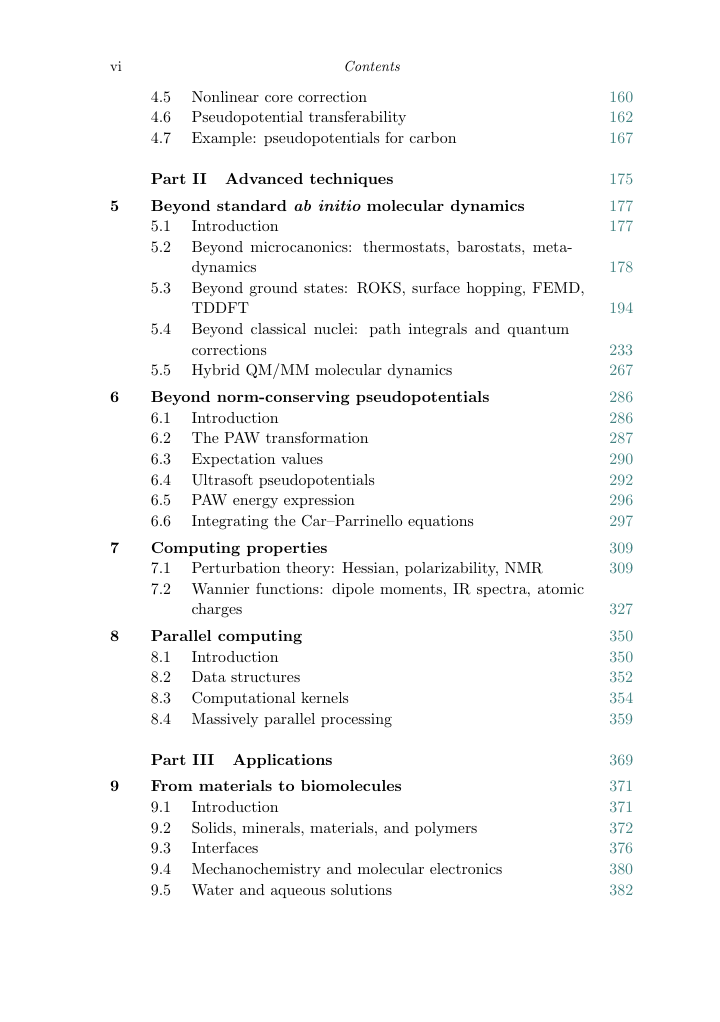Cover
Half-title
Title
Copyright
Contents
Preface
1 Setting the stage: why ab initio molecular dynamics?
Part I Basic techniques
2 Getting started: unifying molecular dynamics and electronic structure
2.1 Deriving classical molecular dynamics
2.2 Ehrenfest molecular dynamics
2.3 Born–Oppenheimer molecular dynamics
2.4 Car–Parrinello molecular dynamics
2.4.1 Motivation
2.4.2 Car–Parrinello Lagrangian and equations of motion
2.4.3 Why does the Car–Parrinello method work?
2.4.4 How to control adiabaticity?
2.4.5 A mathematical investigation
2.4.6 The quantum chemistry viewpoint
2.4.7 The simulated annealing and optimization viewpoints
2.4.8 The extended Lagrangian viewpoint
2.4.9 Analytic and numerical error estimates
2.5 What about Hellmann–Feynman forces?
2.6 Which method to choose?
2.7 Electronic structure methods
2.7.1 Introduction
2.7.2 Density functional theory
2.7.3 Hartree–Fock theory
2.7.4 Post Hartree–Fock theories
2.8 Basis sets
2.8.1 Gaussians and Slater functions
2.8.2 Plane waves
2.8.3 Generalized plane waves
2.8.4 Wavelets
2.8.5 Discrete variable representations
2.8.6 Augmented and mixed basis sets
2.8.7 Wannier functions
2.8.8 Real space grids
3 Implementation: using the plane wave basis set
3.1 Introduction and basic de.nitions
3.1.1 Supercells and plane wave basis
3.1.2 Plane wave expansions
3.1.3 Cuto.s and k-points
3.1.4 Real space grid and fast Fourier transforms
3.1.5 Pseudopotentials
3.2 Electrostatic energy
3.2.1 General concepts
3.2.2 Periodic systems
3.2.3 Cluster boundary conditions
3.3 Exchange and correlation energy
3.4 Total energy, gradients, and stress tensor
3.4.1 Total energy
3.4.2 Wave function gradient
3.4.3 Gradient for nuclear positions
3.4.4 Internal stress tensor
3.5 Energy and force calculations in practice
3.6 Optimizing the Kohn–Sham orbitals
3.6.1 Initial guess
3.6.2 Preconditioning
3.6.3 Direct methods
3.6.4 Fix-point methods
3.7 Molecular dynamics
3.7.1 Car–Parrinello equations of motion
3.7.2 Advanced integration
3.7.3 Imposing geometrical constraints
3.7.4 Using Car–Parrinello dynamics for optimizations
3.8 Program organization and layout
3.8.1 Data structures
3.8.2 Computational kernels
4 Atoms with plane waves: accurate pseudopotentials
4.1 Why pseudopotentials?
4.2 Norm-conserving pseudopotentials
4.2.1 Pseudization of valence wave functions
4.2.2 Hamann-Schluter-Chiang conditions
4.2.3 Bachelet–Hamann–Schluter pseudopotentials
4.2.4 Kerker pseudopotentials
4.2.5 Troullier–Martins pseudopotentials
4.2.6 Kinetic energy optimized pseudopotentials
4.3 Pseudopotentials in the plane wave basis
4.3.1 Gauss–Hermite integration
4.3.2 Kleinman-Bylander projection
4.4 Dual-space Gaussian pseudopotentials
4.5 Nonlinear core correction
4.6 Pseudopotential transferability
4.7 Example: pseudopotentials for carbon
Part II Advanced techniques
5 Beyond standard ab initio molecular dynamics
5.1 Introduction
5.2 Beyond microcanonics: thermostats, barostats, metadynamics
5.2.1 Introduction
5.2.2 Imposing temperature: thermostats
5.2.3 Imposing pressure: barostats
5.2.4 Sampling rare events and free energies: metadynamics
5.3 Beyond ground states: ROKS, surface hopping, FEMD, TDDFT
5.3.1 Introduction
5.3.2 A single excited state: ROKS dynamics
5.3.3 A few excited states: explicit nonadiabatic dynamics
5.3.4 Many excited states: free energy functionals
5.3.5 RT-TDDFT: explicit real-time propagation
5.3.6 LR-TDDFT: linear response and gradients
5.3.6.1 Time-dependent linear response method
5.3.6.2 Tamm–Danco. approximation
5.3.6.3 Dynamical polarizability and oscillator strengths in extended systems
5.3.6.4 Derivatives and LR-TDDFT molecular dynamics
5.3.6.5 Analysis of electronic excitations
5.4 Beyond classical nuclei: path integrals and quantum corrections
5.4.1 Introduction
5.4.2 Ab initio path integrals: statics
5.4.3 Ab initio path centroids: dynamics
5.4.4 Ab initio path integrals: spectroscopy
5.4.5 Quantum corrections of classical susceptibilities: infrared spectra
5.4.6 Related ab initio quantum approaches
5.5 Mixed quantum/classical hybrid molecular dynamics 5.5.1 Introduction
5.5.2 Embedding in atomistic environments
5.5.2.1 CP-PAW/AMBER interface
5.5.2.2 CPMD/GROMOS interface
5.5.2.3 EGO/CPMD interface
5.5.3 Embedding in continuum environments
5.5.4 QM/MM molecular dynamics involving excited states
6 Beyond norm-conserving pseudopotentials
6.1 Introduction
6.2 The PAW transformation
6.3 Expectation values
6.4 Ultrasoft pseudopotentials
6.5 PAW energy expression
6.6 Integrating the Car–Parrinello equations
7 Computing properties
7.1 Adiabatic density-functional perturbation theory: Hessian, polarizability, NMR
7.1.1 Introduction
7.1.2 Coupled perturbed Kohn–Sham equations
7.1.3 Nuclear Hessian
7.1.3.1 Selected eigenmodes of the Hessian
7.1.4 Polarizability
7.1.5 NMR chemical shifts
7.1.5.1 Chemical shifts and susceptibilities
7.1.5.2 The gauge origin problem
7.1.5.3 The position operator problem
7.1.5.4 Density functional perturbation theory
7.1.5.5 Pseudopotential correction
7.2 Wannier functions: dipole moments, IR spectra, atomic charges
7.2.1 Introduction
7.2.2 Position operator in periodic systems
7.2.3 Localization functionals
7.2.4 Localization methods
7.2.4.1 Generalized localization procedure
7.2.4.2 Orbital rotations
7.2.4.3 Exponential representation
7.2.5 Wannier functions in Car–Parrinello simulations
7.2.6 Applications: dipole moments, infrared spectra, and atomic charges
7.2.6.1 Molecular dipole moments
7.2.6.2 Solute infrared absorption spectra
7.2.6.3 Atomic charges
8 Parallel computing
8.1 Introduction
8.2 Data structures
8.3 Computational kernels
8.4 Massively parallel processing
Part III Applications
9 From materials to biomolecules
9.1 Introduction
9.2 Solids, minerals, materials, and polymers
9.3 Surfaces, interfaces, and heterogeneous catalysis
9.4 Mechanochemistry and molecular electronics
9.5 Water and aqueous solutions
9.6 Non-aqueous liquids and solutions
9.7 Glasses and amorphous systems
9.8 Matter at extreme conditions
9.9 Clusters, fullerenes, and nanotubes
9.10 Complex and .uxional molecules
9.11 Chemical reactions and transformations
9.12 Homogeneous catalysis and zeolites
9.13 Photophysics and photochemistry
9.14 Biophysics and biochemistry
10 Properties from ab initio simulations
10.1 Introduction
10.2 Boys–Wannier, population, ELF, and Fukui electronic structure analyses
10.3 Dipole moments, infrared and Raman spectroscopy
10.4 Magnetism, NMR and EPR spectroscopy
10.5 Electronic spectroscopy and redox properties
10.6 X-ray di.raction and Compton scattering
10.7 External electric .elds, scanning probe imaging, conductivity, and currents
11 Outlook
Bibliography
Index
















 2023年江西萍乡中考道德与法治真题及答案.doc
2023年江西萍乡中考道德与法治真题及答案.doc 2012年重庆南川中考生物真题及答案.doc
2012年重庆南川中考生物真题及答案.doc 2013年江西师范大学地理学综合及文艺理论基础考研真题.doc
2013年江西师范大学地理学综合及文艺理论基础考研真题.doc 2020年四川甘孜小升初语文真题及答案I卷.doc
2020年四川甘孜小升初语文真题及答案I卷.doc 2020年注册岩土工程师专业基础考试真题及答案.doc
2020年注册岩土工程师专业基础考试真题及答案.doc 2023-2024学年福建省厦门市九年级上学期数学月考试题及答案.doc
2023-2024学年福建省厦门市九年级上学期数学月考试题及答案.doc 2021-2022学年辽宁省沈阳市大东区九年级上学期语文期末试题及答案.doc
2021-2022学年辽宁省沈阳市大东区九年级上学期语文期末试题及答案.doc 2022-2023学年北京东城区初三第一学期物理期末试卷及答案.doc
2022-2023学年北京东城区初三第一学期物理期末试卷及答案.doc 2018上半年江西教师资格初中地理学科知识与教学能力真题及答案.doc
2018上半年江西教师资格初中地理学科知识与教学能力真题及答案.doc 2012年河北国家公务员申论考试真题及答案-省级.doc
2012年河北国家公务员申论考试真题及答案-省级.doc 2020-2021学年江苏省扬州市江都区邵樊片九年级上学期数学第一次质量检测试题及答案.doc
2020-2021学年江苏省扬州市江都区邵樊片九年级上学期数学第一次质量检测试题及答案.doc 2022下半年黑龙江教师资格证中学综合素质真题及答案.doc
2022下半年黑龙江教师资格证中学综合素质真题及答案.doc